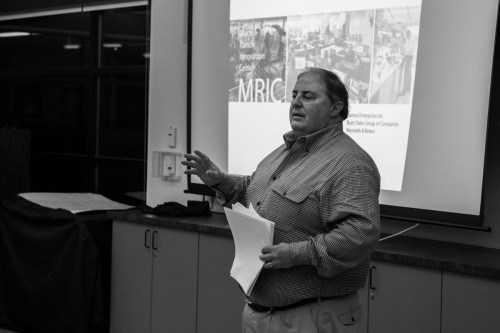
Back in February, the Davis City Council voted 4-1 to direct staff to initiate the EIR certification process for the Mace Ranch Innovation Center (MRIC) location.
This was a contentious issue when it came forward in February, and it likely will remain contentious when it comes back next week to the planning commission and ultimately to the city council.
We argued, after the fact, that both sides of this issue made too much out of it. As even the project proponent pointed out, “certification will not result in project approval.” Moreover, “Additional environmental review will be required, consistent with CEQA, if circumstances or the project itself change before approval is sought.”
Third, “Certification will likely serve to assist the MRIC proponents’ efforts to secure investors and/or tenants, all of which would be useful for achieving the City’s stated goal of fostering economic development and securing a first class innovation center within its boundaries.”
Fourth, “Certification will preserve and conserve the valuable work product contained in the EIR produced by City staff and its team of extensive consultants.”
Much of the opposition to the council even considering certification focused on the fact that the EIR had flaws.
But, as Mayor Robb Davis pointed out, “The Final EIR may be flawed but we cannot formally declare it as so without a certification process.”
To those who argued that this would set a precedent, Councilmember Rochelle Swanson vehemently disagreed, stating, “I disagree about it being precedent setting. This is unusual. This is an investment in our community that I am confident beyond confident that no one else would have stuck it out as long as this.”
She said she met with an investor who wants to invest in our community and “they’re nervous, they’re wondering what we’re going to do. So this is real.”
In response to a concern about “future fighting,” she said, “I don’t believe there will be future fighting if we don’t move forward. Because there won’t be anything to fight about anymore.”
She said we lack research space to do anything we want to do at this point.
“Are we open for business?” she asked. “I don’t think so. That breaks my heart because I’ve invested seven years in this.” She added, “This is an inflection point to decide whether or not we’re really moving forward.”
The next step is more substantial than the one taken back in February. That vote simply opened the door to allow the council to consider certification; this would eventually result in the decision to certify or not certify.
Now the council will have to decide whether the EIR is flawed or not.
In February, Robb Davis stated, “An EIR might enable us to move more quickly.” All Mike Webb would acknowledge is that it wouldn’t hurt to have a document and the analysis that one can go to.
Staff also clarified under what conditions a new EIR or a supplemental EIR would be required. The answer is not only changed circumstances, but more impactful changes. In other words, you can think of the current EIR as a ceiling – so if a new project comes in with a smaller footprint or fewer housing units, in the case of a mixed-use project (that the council still lacks support for), then it would not trigger another EIR.
However, expanding the footprint, the square footage, the impact, could trigger a supplemental.
Even the advantage to the applicant isn’t quite as clear as it might seem.
On the one hand, you have the comment from Mike Webb that having a certified EIR might speed up the process, but, on the other hand, he also made it clear that there was no expiration date for the work done to date.
That means, in point of fact, there is no ticking clock for certification. They could simply sit on what they have and add to it in the future for a new project.
In February, we concluded this doesn’t open the door to the new project.
First, council has not made a determination to certify the project. They have only decided to review the Final EIR and then will decide whether it is sufficient.
Even if they end up certifying the EIR – there needs to be a project (which there is not one now). The project still needs to go to a vote of the council and then to the public to be approved.
It bears repeating that no project has won a Measure R vote. Some have argued that this will make it less likely that one would be approved, but it stands to reason that by the time a project comes forward, whether or not they have to do an additional EIR, the public can evaluate the strengths and weaknesses of the project based on the merit of the project before them, rather than about a small decision that was made a few years early at best.
More likely than not, there will be additional environmental evaluation for any project coming forward.
In the end, unless the developer puts forth a viable project, this is all a moot point anyway.
—David M. Greenwald reporting







One major challenge for the planning community remains the fact that EIR’s are not designed to allow for a true understanding as to the consequences of doing nothing under the basecase scenario.
What are the ramifications on city and county finances of doing nothing – over the next 20 years? What are the consequences for our increasing number if graduates of not seeking space for new employers? Demographic consequences for senior services? For our local school district? For future county services? For other communities eclipsing Davis as the local, “go to” technology employment hub?
And, as but one example, the process has no “plug in slot” for the findings of Project TOTO and its ramifications for future quality of the local Davis ecosphere.
Thinking about our future in a more holistic context would be a good start, and this important project could provide a valuable jumping off point to begin such an analysis.
John… as it stands, the EIR, under CEQA, does not require analysis of economic factors. But I think you realize that…
A separate analysis covering the points (revenue/economic) you make would be a valuable tool if and when a specific project is presented. I support such an analysis, particularly as such a project would be subject to a J/R vote.
I believe the EIR should be seriously considered for certification NOW.
If a specific project comes forward that does not fit in the “envelope” of the EIR, additional CEQA work will be needed, but not necessarily a “do-over”. Even if such a project “fits” there will need to be ‘findings’ as to why it fits. All within a public process…
It would be a ‘shame‘ not to move forward, on the current EIR… if adequate, certify it… if not, say so, and cite the inadequacies. Time to fish or cut bait
John and Howard, I suspect that the exclusion of economic factors isn’t likely to change any time soon. The number of scenarios that would be needed to address all the various stakeholder interests would be too numerous to count . . . and would be fraught with personal subjectivity. That is not to say the economic impacts shouldn’t be disclosed and evaluated, but I believe that should be done in a separate process from CEQA.
With that said, there is (in my opinion) a serious flaw in the assessment of the environmental impacts of the no project alternative. Specifically, as currently implemented those impacts stop at the jurisdictional limits of the jurisdiction conducting the CEQA analysis . . . the City Limits of the City of Davis (either current or anticipated). That means the greenhouse gas contributions of people who commute to and from Davis are not considered in any of the alternatives, and that means we can not see the true incremental environmental impact of the various alternatives. That is like pouring 10 pounds of sugar into a 5 pound bag and only looking at the bag when you are done . . . and not all the sugar spilled all over the surface. What CEQA (as it currently exists) encourages jurisdictions to do is sweep all that spilled sugar under the rug and pretend it doesn’t exist.
It isn’t the ‘jurisdiction’ that is doing the ‘sweeping’ in Davis, but project opponents. It is so much easier to claim that ‘no project’ and ‘slow-growth’ are environmentally favorable when you don’t have to account for the impacts of all those commuting into town every day for lack of appropriate housing.
Both/And, Mark . . . both/and.
Agreed.
To your commets, however, it is totally disingenuious to suggest there are no environmental consequences to a community and a region as the result of a broken economy, increasing taxes, and faulure to address consequences of profound demographic shifts over the era addressed by the analysis – whether university enrollment, shifting age demographics, or trends in home ownership.
Then, get the legislature to change the law.
I am personally opposed to that approach.
I could fully support the City having a separate analysis covering some or all the points you cited… but NOT under the aegis of CEQA. Still part of the community/CC decision process.
I concur with Howard . . . a separate analysis covering some or all the points you cited… but not under the aegis of CEQA. Still part of the community/City Council decision process. It would probably necessitate some coordinated effort of the Planning Commission and the FBC.
Point being, this process is the opportunity for a community and its planners to take stock of how a given project fits into the future fabric, environment and needs of the community. In this context, the traditional EIR is about as outmoded and useful as a traditional city budget.
That’s a good point. How would you suggest we fix it though?
As with Howard’s suggestion above – about not necessarily needing a ‘do-over’ – I think the same situation exists on the planning/visioning side. We have the results of an extensive discussion/visioning process that came up with the need for commercial expansion and resulted in the City’s 2014 Request for Expressions of Interest (RFEI) for innovation center proposals. If anything, the fiscal challenges that drove that discussion/visioning have expanded, not contracted, so there is little reason to go back through that entire process again.
On top of those fiscal concerns, we have now more recently begun the process of coming to grips with the pressing housing shortage in town, though there still is no consensus on how to move forward there. I think one smart approach would be to build upon the existing RFEI as the baseline (including all the underlying work leading to that request) and add a focused examination of whether or not high-density workforce housing should be added as an option for new or amended project proposals. We need to get serious about addressing the needs of our community, which include the City’s fiscal shortfalls, and the serious housing shortage. This approach would move towards solutions to both problems without requiring a multi-year do-over of the community’s previous visioning work that has already been completed.
David, my suggestion is that a separate and parallel process evaluate the economic impacts in a structured process. Imagine the ad-hoc process that we experienced during the Hyatt House consideration, happening in a structured process. The neighbors would have had a clear path for formal consideration of the impacts they felt were being imposed on them. Similarly, Roshan Patel would have a clear path for formal consideration of the impacts of the additional hotels on the existing hotel marketplace.
Next phase of Project TOTO along with a heavy dose of introspection versus obfuscation and distraction.
Actually, I think it is a “poor” point on a project per project basis…
Howard,
No fundamental disagreement with your critique. However in the absence of a functioning, intact Comprehensive Plan – the need still remains for a holistic approach to addressing our needs as a community.
Current GP plan and tools are inadequate for the task. As a result projects like MRIC suffer along with the community.